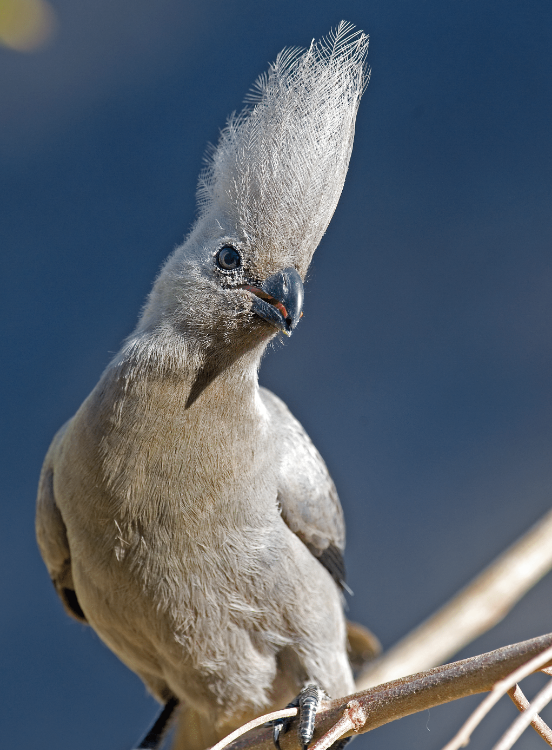Bird’s-eye view – Marico sunbird
December 5, 2012Namibia bags another green award for climate change adaptation
December 6, 2012by Ron Swilling
Time for the endemics
When the storms of summer are but a sweet memory, the Namibian winter offers new and different opportunities and experiences.
It’s the dry time of the year when waterholes shrink and grass turns golden. The summer avian visitors, the migrants – African and Palaearctic – have returned home, leaving the Namibian residents behind for the winter.
This is, therefore, an opportune time to see the Namibian endemics in the arid Namib, PreNamib and bushveld areas. With the exception of the Damara tern – an intra-African migrant that migrates northwards to the bulge of Africa, returning south to breed – they are all resident birds.
This is the slower time of the year, without the glitz and glamour of the summer breeding season. Birds such as weavers, bishops and paradise flycatchers are out of their colourful breeding plumage, and are now dressed in their day-to-day outfits, the sexes indistinguishable from each other.
- In the Windhoek area, look out for Monteiro’s hornbill (larger than the other hornbills), White-tailed shrikes, and rockrunners.
- The Waterberg area is good for spotting rockrunners, the striking blue and yellow flashes of Rüppell’s parrot on the wing, Carp’s tit and Hartlaub’s francolin, and
- in the PreNamib – the scrub bordering the desert – Benguela long-billed lark and Rüppell’s korhaan.
- On the coastal gravel plains, keep your eyes open for Gray’s lark, Damara tern and Dune lark, and in
- the central gravel plains around inselbergs such as the Spitzkoppe and Brandberg, the Benguela long-billed lark.
- The Herero chat, with its distinctive black patch running through its eye to its ear coverts in pirate fashion, is the prime attraction in the Spitzkoppe-Brandberg area, its distribution extending through Damaraland into Angola.
- Along river courses and in woodland areas in the north-west, the attractive Violet wood-hoopoe and family groups of chattering Bare-cheeked babblers can be seen (and heard).
A special time – winter birding in the north-east
The Caprivi and Kavango regions, usually a cacophony of sound, quieten down during the winter months. The non-migrant or resident Southern African ‘specials’ (that is birds which occur there as well as in other areas, but not in great numbers) are found this time of year, making it a prime time to observe the specials.
Although winter is the optimum game-viewing period as there’s no rain, less mud and mosquitoes, and easier visibility as the forest thins out, the birds are less vocal and it takes a little more effort to view the avian bounty in its entirety.
There are still, however, enough waterbirds to dazzle – elegant herons skim the water and the sound of the fish-eagle rings through the air on the Kwando and Zambezi waterways.
Skimmers, White-crowned lapwings and pratincoles can usually be seen when the water level is lower.
This is a favourable time to spot African skimmers nesting on the sandbanks and Rock pratincoles on exposed river rocks.
North-eastern Namibia is a good locale to view Dickinson’s kestrel, Western banded snake-eagle, the large ginger-coloured Pel’s fishing owl, White-backed night-heron, Slaty egret with its yellow legs and rufous throat, Black coucal and Rosy-throated longclaw.
The Brown firefinch, a sought-after species, can also be seen, as can the Sharp-tailed starling, Rufous-bellied tit and Shelley’s sunbird. The African hobby, White-breasted cuckooshrike, Racket-tailed roller, Arnot’s chat, Wattled crane, Chirping cisticola and Greater swamp-warbler are additional specials to look out for in the north-east.
Visitors may also be able to see several Carmine bee-eaters that haven’t joined the annual migration to equatorial Africa, but have remained for the winter. The bee-eaters begin breeding in holes along the riverbanks early in the season in August. The distinctive bird, with its dark turquoise crown, is always a bright attraction of the area.
The bubbling call of the Coppery-tailed coucal reverberates through the waterways, adding to the evocative sounds – hippos grunting and the chiming of painted reed frogs – that make a visit to the Caprivi and Kavango regions so appealing.
Namibia’s endearing endemics
The word endemic indicates a species that occurs only within a certain country.
The Dune lark is the only bird species in Namibia considered a true endemic.
It is found in the vegetated coastal dune belt from Lüderitz up to the Kuiseb River, just south of Walvis Bay.
There are another 13 species that are often referred to as endemics, although they are essentially near-endemics insofar as their distribution extends into another area, in this case Angola, because the largest populations of the species are found within Namibia.
- Dune lark
- Monteiro’s hornbill
- Damara red-billed hornbill
- White-tailed shrike
- Carp’s tit
- Hartlaub’s francolin (spurfowl)
- Herero chat
- Rüppell’s korhaan
- Rockrunner
- Bare-cheeked babbler
- Benguela long-billed lark
- Gray’s lark
- Violet wood-hoopoe
- Rüppell’s parrot
This article appeared in the Winter 2012 edition of Travel News Namibia.







